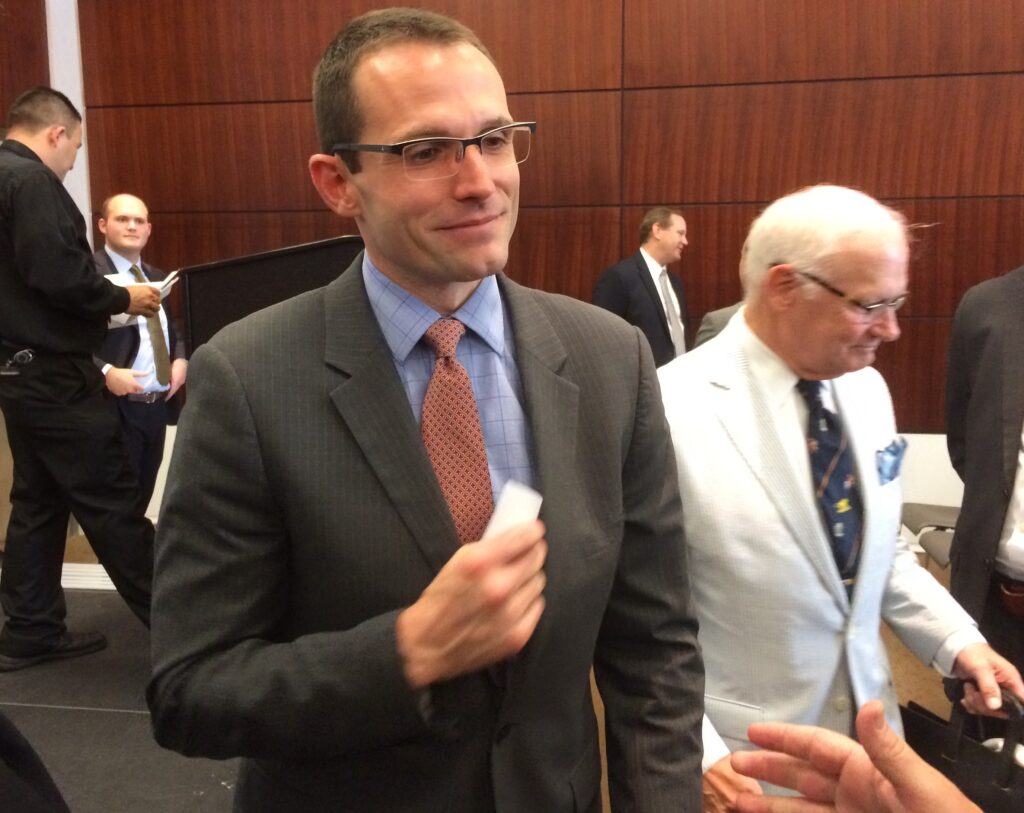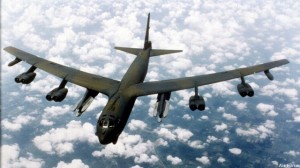
William Roper
DARPA HQ, ARLINGTON, Va.: Reporters must stop asking Will Roper about the Arsenal Plane, because he hasn’t picked which aircraft will be rebuilt as a high-tech truck for long-range missiles and other weapons. Speculation has centered on the Air Force B-52, but the Strategic Capabilities Office director made clear that choice is, well, up in the air.

B-52H Stratofortress
“Everyone is interested in the arsenal plane,” Roper said, smiling, as he demurred time and again to offer details during this morning’s media roundtable here. “We haven’t announced what the plane is…to give ourselves the maximum set of options until we’re ready to pick the one.”
“Learning and discovery is part of the process,” he said. “It’s not until we start doing the engineering of trying to make them an arsenal plane that we (discover) which one can do the best job.”
The core concept “makes tons of sense,” he said. Network dispersed unmanned sensors — drones, satellites, and so on — to transmit targeting data to long-range missiles launched from manned platforms well outside the enemy’s reach. That’s already how Navy ships engage enemies far beyond their own radar range, attacking targets deep inland with Tomahawk cruise missiles and defending against incoming strikes with Standard Missile (SM) interceptors. (One of SCO’s early successes is reprogramming SM-6s and Tomahawks to hit ships as well).
[Read our exclusive two-part interview with Roper here and here]
Taking existing good ideas from one domain and applying them to another — e.g. from the Navy to the Air Force — helps SCO make big operational impacts without developing all-new technology. But it’s not an easy copy-and-paste, because each domain has its own technological hurdles. In the air, “things move very, very quickly,” from targets to threats to friendly aircraft, Roper said. But modern computing is increasingly capable of handling such jet-speed jigsaw puzzles. “We are at the cusp of doing the integrated operations in the air that the Navy has been doing on the surface.

A Navy ship launches an SM-6 missile
“We have partnered with the Air Force (on) a viable way of creating that concept,” Roper said. Working closely with the four armed services is crucial to SCO’s success, he emphasized. In turn, the Strategic Capabilities Office helps the services in two crucial ways:
First, SCO funds high-risk projects that the cash-strapped services can’t afford to bet on, maturing technology until the services can take it over. This approach is similar to DARPA’s — high risk and high reward, mature the tech and hand it to a service — but on a much tighter timescale. DARPA works on breakthrough technologies a decade from fruition, SCO on upgrading or repurposing existing tech. [A clarification: DARPA also provided the SCO a room to hold the roundtable, since Roper’s fledging office has little space of its own, but the two organizations are entirely separate entities within the Defense Department.]
Second, SCO cross-pollinates among the services. A technology proposed to the Air Force for one mission, for example, might actually have a bigger impact on the Army, or vice versa. For example, the Hyper Velocity Projectile (HVP), which could allow conventional artillery to shoot down cruise missiles and aircraft, began in Navy railguns but is now being tested in Army howitzers.

Army 155 mm howitzer
As the services stand up their own Rapid Capabilities Offices — the Army is the latest — SCO’s crucial role is as the “cross-service connector” for all these disparate efforts. It’s almost like a dating site pairing up people who’ve never met based on common interests, Roper said: “We have done quite a bit of Match.mil.”
Given these two principles, savvy innovators from industry have learned two things not to do when approaching SCO, Roper said.
“They know not to bring in immature technology,” he said. Nascent tech is DARPA’s business, but SCO likes to take on tech at about Technological Readiness Level (TRL) 4 — the components are proven to work in the lab — and then fund maturation to TRL 6 — do an “operational demonstration” under realistic conditions — before handing it over to a service. That process that typically takes three years, Roper said, with SCO generally providing all or most funding at the start but the service eventually taking over.
“It gives a three-year buffer that allows a service to look at an idea without being tied to it,” Roper said. “They’re partnered. Their logos are on our slides. They are an integral part of the team because of their expertise” — but they’ve not committed their own money.
The second lesson: Don’t presume you know what your technology should be used for. “I am encouraging industry now to not bring in traditional pitches the way that they do to many program offices,” Roper said. “I tell them to just bring a deck of slides –unstructured, unformatted — that (show) all the things you’re doing. Let us help you find the mission.”
“It’s too much to ask a great engineer to also be a great strategist,” Roper said. “We have to be very good strategists and analysts here,” he said. “What we can give to them (the engineers) is the context for which it will be used.” SCO largely relies on outsiders for technical expertise — after all, the world expert on a technology is whoever invented it — and sees its unique value-added as matching tech to missions that its inventors may never have thought of. Roper sees SCO’s biggest gift to the US Army, for example, not in terms of some robot tank but of combining big data, machine learning, and augmented reality to help comprehend the chaotic complexity of urban warfare.

Defense Secretary Carter talks to Roper at Submarine Base New London.
SCO is currently in the final throes of selecting which new projects to champion in the 2018 budget. “August is our busiest month,” Roper said, but he’s still reading slides round the clock.
Because SCO gets almost all its budget on a project-by-project basis, and those projects must compete for funding with everything else in the Defense Department, “there’s this extreme urgency right now,” Roper said. “If the ideas ever become sub-par, if they’re not compelling enough to fund, the office goes away, (because) it’s not fulfilling its purpose.”
Roper thinks that competitive pressure cooker is crucial, but there is an argument to be made for more permanent “topline” funding of SCO. Having money on hand would let SCO could quickly reprogram funds (with Congressional approval) to start projects ASAP, rather than having to wait for the budget cycle. When he finds a great new idea, Roper said, “my biggest frustration running SCO (is), the way our budget process works in the government, I can’t start it for at least a year.”
That’s particularly limiting for an office focused on near-term upgrades to existing weapons systems. “There are lots of people working on the future,” Roper said, “but we are tomorrow.”
Air Force picks Anduril, General Atomics for next round of CCA work
The two vendors emerged successful from an original pool of five and are expected to carry their drone designs through a prototyping phase that will build and test aircraft.


























